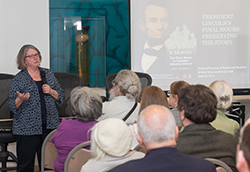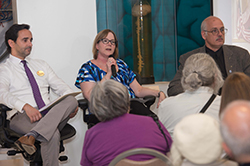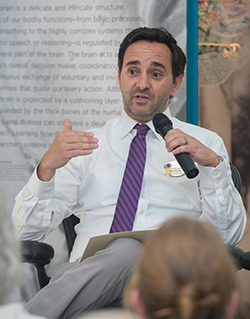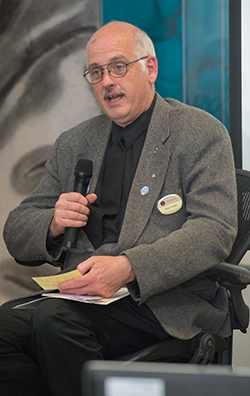Lincoln artifacts examined during 150th anniversary tribute
By Paul Bello, National Museum of Health and Medicine
SILVER SPRING, Md. - Collections staff at the National Museum of Health and Medicine (NMHM) stepped out from behind the scenes recently to lead a discussion focusing on objects and specimens related to President Abraham Lincoln's assassination in 1865. NMHM concluded its sesquicentennial look back at this pivotal moment in American history during its monthly Medical Museum Science Café, April 28.
Staff at NMHM, formally known as the Army Medical Museum, played important roles through this national tragedy, according to Andrea Schierkolk, public program manager for NMHM. Through the years, she said the museum has assumed an ongoing role in the collection and care of items related to Lincoln during his last hours and the telling of those stories to the general public.
One such item that carries a great volume of case histories is the Medical and Surgical History of the War of the Rebellion, a publication documenting the casualties of the Civil War, as well as Lincoln's wound and the treatment he received following the attack. The museum's collection also contains a photograph taken two days after Lincoln's assassination by famed photographer Matthew Brady. His job was to replicate what the presidential box at Ford's Theatre looked like at the time the president was shot, Schierkolk said.
The bullet that killed Lincoln, which was fired from a Deringer pistol, was submitted to the Judge Advocate General's office as evidence that would be used in the trial against John Wilkes Booth and the other conspirators. It remained there until 1940, along with several bone fragments and a Nelaton's probe. It was then transferred to the National Park Service and later donated to the Army Medical Museum in June 1956. Other items of interest include the shirt cuffs and piece of bone extracted from Lincoln's skull by Dr. Edward Curtis, who was one of the doctors assisting at Lincoln's autopsy. The museum received these items from Curtis' son in 1947, according to Alan Hawk, NMHM historical collections manager.
"When Curtis returned home from the autopsy, he saw that his cuffs were stained with Lincoln's blood. He showed this to his wife, who realized their importance and in turn cut them off and placed them in an envelope," Hawk said. "Curtis would discover the piece of bone while cleaning his tools the next morning. This is on display along with the other bone fragments that were removed at the autopsy."
Hawk said the collection also includes a portrait of Joseph K. Barnes, who was the U.S. Army surgeon general from 1864-1882. He relieved William Hammond, who was the founder of the Army Medical Museum. Barnes is credited with carrying on several reforms of his predecessor, but none more important than the continuation of the Army Medical Museum.
Barnes is also responsible for summoning Hermann Faber, a hospital steward detailed to the Army Medical Museum, to the Petersen House in order to sketch the now famous Lincoln deathbed scene. Credited as one of the founders of professional medical illustration, Faber was given a list of known attendants and their positions in the room by Barnes himself.
While many sketches have been produced over the years of Lincoln's deathbed, Faber was the only artist allowed to draw directly from the scene, according to Eric Boyle, NMHM archivist. Faber's original sketch of this scene is currently on exhibit for a limited time.
Boyle said one of the better accounts of the assassination comes from Dr. Charles Leale, who was the first doctor at the scene when Lincoln was shot the evening of April 14, 1865. Leale would tell his story 45 years later in a speech commemorating the 100th anniversary of Lincoln's birthday. A copy of Leale's report was eventually donated to NMHM in 1951 by his granddaughter.
"Leale laid out his recollections of that night and what happened into the next morning," Boyle said. "Leale reported that when he first looked at Lincoln he appeared to be dead. His eyes were closed and he had fallen forward. He was held upright by the grip of Mrs. Lincoln."
Boyle added that after Leale finished examining Lincoln he pronounced his diagnosis and prognosis, which would soon be telegraphed all over the country, "His wound is mortal. It is impossible for him to recover."
Based on Leale's account, Hawk explains it was clear there was no positive ending to this attack and that Lincoln was going to die. This was incredibly disheartening to a group of doctors and military officers dedicated to taking care of someone, particularly their country's leader.
This somber sentiment lingered in the aftermath following Lincoln's death. Shortly after Mary Todd Lincoln requested a lock of her husband's hair, all the doctors present at the autopsy requested a lock of hair, as well. According to Hawk, the first official Lincoln artifact the museum procured was a lock of hair donated by Barnes' wife in 1889. Another would follow in 1920.
"There's also a mourning badge from assistant surgeon Eugene Shaw, who served in the 116th New York Volunteers," Hawk said. "This is an item worn by someone far removed from this event, but was a family keepsake for many years until it was donated to us in 1937."
Ford's Theatre was turned over to the government after Lincoln's assassination and no other plays were held there, Schierkolk said. In 1866 space at the theatre was used by the Army Medical Museum and stayed that way for two decades.
"Visitors to NMHM often ask how the museum has acquired such items," said Dr. Adrianne Noe, NMHM director. "This program was an opportunity to explore some of those questions and to showcase our new Lincoln exhibit."
The NMHM was founded as the Army Medical Museum in 1862 and moved to its current location in Silver Spring, Maryland in 2012. For more information on upcoming events, please call 301-319-3303 or visit www.medicalmuseum.mil.

|
Caption:
Dr. Adrianne Noe, director of the National Museum of Health and Medicine, welcomes guests to NMHM's April Medical Museum Science Café for a discussion on the assassination of President Abraham Lincoln in 1865. Throughout the month, NMHM recognized the 150th anniversary of Lincoln's assassination with various programs and activities.
(Disclosure: This image has been cropped to emphasize the subject.) (National Museum of Health and Medicine photo by Matthew Breitbart / Released) |

|
Caption:
Andrea Schierkolk (center), public program manager at the National Museum of Health and Medicine, is joined by NMHM colleagues, archivist Eric Boyle (left) and historical collections manager Alan Hawk (right), for a discussion regarding President Abraham Lincoln's assassination, April 28, 2015.
(Disclosure: This image has been cropped to emphasize the subject.) (National Museum of Health and Medicine photo by Matthew Breitbart / Released) |

|
Caption:
Eric Boyle, archivist at the National Museum of Health and Medicine, elaborates on the various Lincoln deathbed sketches produced over the years, at NMHM's Medical Museum Science Café, April 28, 2015.
(Disclosure: This image has been cropped to emphasize the subject.) (National Museum of Health and Medicine photo by Matthew Breitbart / Released) |

|
Caption:
Eric Boyle, archivist at the National Museum of Health and Medicine, elaborates on the various Lincoln deathbed sketches produced over the years, at NMHM's Medical Museum Science Café, April 28, 2015.
(Disclosure: This image has been cropped to emphasize the subject.) (National Museum of Health and Medicine photo by Matthew Breitbart / Released) |

|
Caption:
Alan Hawk, historical collections manager at the National Museum of Health and Medicine, discusses the care President Abraham Lincoln received prior to his death during NMHM's Medical Museum Science Café, April 28, 2015.
(Disclosure: This image has been cropped to emphasize the subject.) (National Museum of Health and Medicine photo by Matthew Breitbart / Released) |



